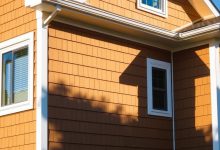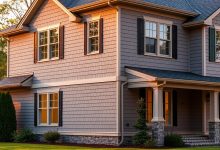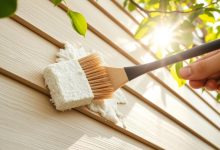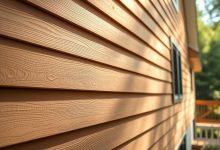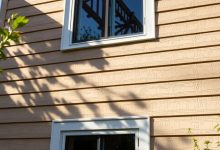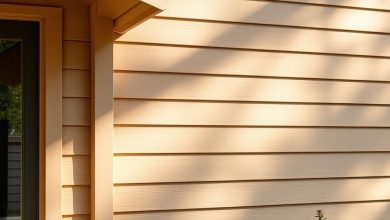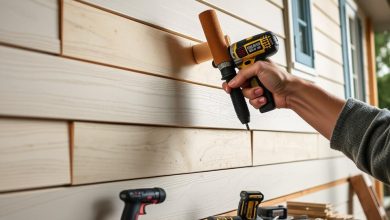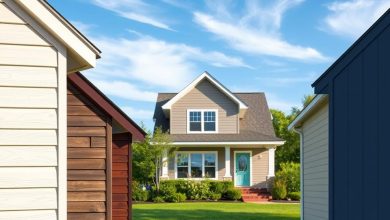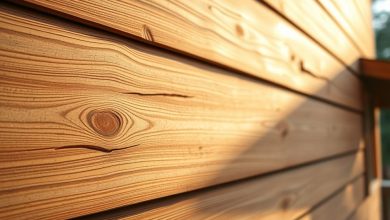Insulated Siding Prices: Average Cost per Sq Ft Explained
When thinking about home renovation, knowing insulated siding prices is key. The average cost per sq ft changes based on several things. These include the siding material, how hard it is to install, and where you live.
In the U.S., more people are choosing insulated siding. It saves energy and lasts a long time. But, it can cost a lot upfront. So, it’s important to know what affects the average cost.
Knowing these details helps homeowners make smart choices for their projects. This article will cover insulated siding’s benefits and what affects its price.
Key Takeaways
- Understanding the factors that affect insulated siding prices.
- Learning about the average cost per sq ft for different materials.
- Discovering the benefits of choosing insulated siding for your home.
- Exploring how location and installation complexity impact costs.
- Identifying ways to make informed decisions about your renovation project.
What Is Insulated Siding?
Insulated siding is a big step forward in building tech. It’s a strong, energy-saving exterior solution. It combines the protection of regular siding with insulation, making homes more energy efficient.
Definition and Components
Insulated siding has a special design. It usually has a siding material like vinyl or fiber cement, with foam insulation behind it. The foam insulation is key because it keeps heat in winter and out in summer.
What makes up insulated siding can change based on who makes it. But most have a few things in common:
- A cladding layer on the outside, made from materials like vinyl, fiber cement, or engineered wood.
- A foam insulation layer, often from rigid foam plastic.
- A backing material for extra support and to hold the siding in place.
Benefits of Insulated Siding
Insulated siding offers many advantages. It’s great for those wanting to save energy and make their homes last longer. Some main benefits are:
| Benefit | Description |
|---|---|
| Energy Efficiency | It helps keep homes warm in winter and cool in summer by reducing heat transfer. |
| Durability | It gives a tough exterior that can handle different weather. |
| Reduced Noise | The insulation layer can make homes quieter by blocking outside sounds. |
| Increased Home Value | It can make a home more valuable by improving its energy use and look. |
Knowing about insulated siding helps homeowners choose better exterior options. It can lead to big energy savings and a more durable home.
Types of Insulated Siding Materials
Insulated siding comes in vinyl, fiber cement, and wood. Each meets different needs and tastes.
Vinyl Insulated Siding
Vinyl insulated siding is loved for its durability and low maintenance. It has insulation between vinyl and a backing. This setup reduces heat transfer and boosts energy efficiency.
- Cost-effective compared to other materials
- Resistant to pests and weathering
- Available in various colors and styles
Fiber Cement Insulated Siding
Fiber cement is a solid choice, known for resistance to fire and pests. It’s made from cement, sand, and cellulose fibers. This gives a tough and lasting exterior.
- Offers superior durability compared to vinyl
- Can mimic the appearance of wood
- More expensive than vinyl siding
Wood and Engineered Wood Options
Wood and engineered wood offer a traditional or natural look. They have a unique beauty and can be treated for durability.
- Provides a natural, authentic appearance
- Can be more expensive than other options
- Requires periodic maintenance
Each material has its pros and cons. Homeowners should think about their needs and likes when picking insulated siding.
Factors Affecting Insulated Siding Cost
Insulated siding cost varies a lot. It depends on many different things for each project.
Knowing these factors helps homeowners make smart choices for their home improvements.
Material Quality and Brand
The type and brand of insulated siding matter a lot for the cost.
Top-quality materials with better insulation, durability, and looks cost more.
For example, CertainTeed and James Hardie are known for their high-quality siding. But it’s pricier.
Experts say, “The material’s quality is key for the siding’s cost and how well it works.”
“Choosing the right material can greatly impact energy savings and upkeep costs.”
Home Size and Configuration
The home’s size and shape also affect insulated siding costs.
Bigger homes need more siding, which raises the price.
Also, homes with many stories, angles, or special cuts cost more to install. This is because the job is more complex.
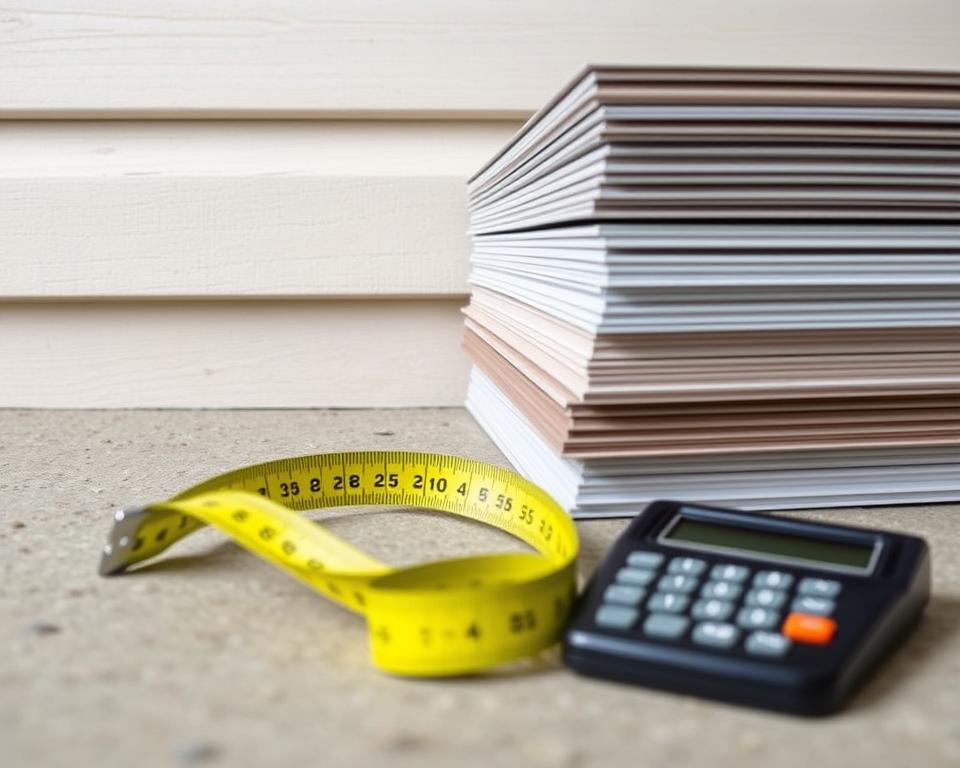
Geographic Location
Where you live also changes the cost of insulated siding.
Different places have different labor costs, material availability, and rules. These all affect the final price.
In areas with high labor costs or strict building rules, siding costs can go up.
A report notes, “Local factors can really change material and labor costs. It’s wise to get quotes from local experts.”
Removal of Existing Siding
Removing old siding is another cost factor.
If the old siding is bad or needs to be taken out for the new siding, it adds to the cost.
The cost to remove old siding varies. It depends on the type and how hard it is to remove.
Insulated Siding Cost per Square Foot
Understanding the cost per square foot of insulated siding is key. It greatly affects your budget.
The cost varies based on material quality, brand, and other factors. Homeowners can expect to pay within certain ranges based on their choices.
Budget Options ($4-$7 per sq ft)
For those on a tight budget, quality insulated siding is available. Budget-friendly options cost between $4 and $7 per square foot. These include basic vinyl products that are energy-efficient and durable.
Mid-Range Options ($7-$12 per sq ft)
Mid-range options, priced from $7 to $12 per square foot, offer a balance. They include higher-end vinyl or fiber cement siding. These have better insulation and are more durable.
Premium Options ($12-$20+ per sq ft)
For top-quality, premium insulated siding costs $12 to $20 or more per square foot. These have advanced materials, superior craftsmanship, and long warranties. They offer long-term value and energy savings.
Regional Price Variations
Prices for insulated siding also vary by region. This is due to local labor costs, material availability, and climate. Homeowners should research local prices for an accurate estimate.
Installation Costs and Considerations
Insulated siding installation has several cost factors homeowners need to know.
Understanding these costs helps make better decisions for your siding project.
DIY vs. Professional Installation
Choosing between DIY or professional installation is a big decision.
DIY Installation: DIY can save on labor costs but needs a lot of time, skill, and the right tools.
Professional Installation: Professionals offer expertise and efficiency, which can save money in the long run.
Labor Costs by Region
Labor costs vary by region due to cost of living, labor laws, and demand for contractors.
| Region | Average Labor Cost per Sq Ft |
|---|---|
| Northeast | $3 – $5 |
| South | $2.50 – $4 |
| West Coast | $4 – $6 |
Additional Installation Expenses
Other expenses can also affect the total cost of installation.
These include permits, disposal fees for old siding, and repairs to the structure.
Seasonal Pricing and Timing Your Project
Seasonal pricing is key when it comes to insulated siding costs. Knowing how to use this can save you a lot of money. As a homeowner, understanding how seasons affect prices and availability is important. It helps you make smart choices.
Off-Season Discounts
Contractors and suppliers give discounts in the off-season, usually late fall and winter. With less demand, you can save money if you plan ahead.
Benefits of off-season discounts include:
- Lower material costs
- Faster installation
- Better labor rates
Best Time to Purchase and Install
The best time to buy and install insulated siding varies by location and needs. Spring and early fall are usually best due to good weather.
Here’s when to consider for your project:
| Season | Pros | Cons |
|---|---|---|
| Spring | Mild weather, easy installation | Higher demand, longer wait times |
| Early Fall | Favorable weather, less humidity | Some contractors busy with summer projects |
| Late Fall/Winter | Off-season discounts, faster installation | Colder weather complicates installation |
Cost Comparison: Insulated vs. Non-Insulated Siding
Choosing between insulated and non-insulated siding means looking at both the upfront cost and long-term savings. Homeowners need to weigh the initial expenses against the long-term advantages of insulated siding.
Initial Investment Differences
Insulated siding costs more at first than non-insulated siding. This is because it has an extra layer of insulation. This can add $1 to $3 per square foot to the price. For a 2,000 square foot home, this means an extra $2,000 to $6,000.
Cost Breakdown:
| Siding Type | Cost per Sq Ft | Total Cost for 2,000 Sq Ft |
|---|---|---|
| Non-Insulated Siding | $4-$7 | $8,000-$14,000 |
| Insulated Siding | $7-$12 | $14,000-$24,000 |
Long-Term Cost Benefits
Insulated siding costs more upfront but saves money in the long run. It helps keep your home warmer in winter and cooler in summer. This can cut down on heating and cooling bills.
The U.S. Department of Energy says homes with good insulation can save 10% to 30% on energy. For example, if your energy bills are $2,000 a year, insulated siding could save you $200 to $600 annually. Over 10 years, that’s $2,000 to $6,000 saved, which can cover the extra cost of insulated siding.
In summary, though insulated siding costs more at first, its long-term savings make it a smart choice for many homeowners.
Return on Investment and Energy Savings
Insulated siding is a smart choice for homeowners. It boosts your home’s value and saves energy.
Insulated siding adds a strong exterior to your home. It also saves money on energy bills over time.
Energy Efficiency Benefits
Insulated siding adds extra insulation. This means less heat loss in winter and less heat gain in summer. Your home stays at a steady temperature, needing less heating and cooling.
The U.S. Department of Energy says insulated siding can cut heating and cooling costs by up to 30%.
| Insulation Type | Energy Savings | Average Cost |
|---|---|---|
| Insulated Vinyl Siding | 15%-25% | $4-$7 per sq ft |
| Insulated Fiber Cement Siding | 20%-30% | $7-$12 per sq ft |
| Insulated Wood Siding | 25%-35% | $12-$20 per sq ft |
Impact on Home Value
Insulated siding also boosts your home’s value. A modern, energy-efficient exterior attracts buyers.
Key benefits include:
- Increased energy efficiency
- Improved curb appeal
- Enhanced durability
A study by the National Association of Realtors shows siding upgrades can recoup up to 80% of the cost at resale.
In summary, insulated siding is a wise investment. It increases your home’s value and cuts energy costs.
Warranties and Long-Term Value
When you invest in insulated siding, knowing about warranties and long-term value is key.
Insulated siding boosts your home’s look, saves energy, and guards against weather.
Manufacturer Warranties
Warranties from the maker are vital for insulated siding. They protect against defects and ensure the product works as promised.
Warranty lengths can differ a lot between makers. Some offer a lifetime warranty on certain items.
For example, some vinyl siding comes with a lifetime guarantee against fading, cracking, and damage.
“A well-crafted warranty can be a significant factor in choosing the right insulated siding for your home.”
It’s important to read warranty terms well. Know what’s covered and for how long.
Contractor Guarantees
Contractor guarantees are also key for insulated siding’s long-term value.
A good contractor will back their work with guarantees against installation mistakes.
This includes guarantees against leaks, wrong installation, and other problems.
Ask contractors about their guarantee policies. Make sure you’re okay with the terms.

| Warranty Type | Typical Coverage | Duration |
|---|---|---|
| Manufacturer Warranty | Defects, fading, cracking | Lifetime or 20-30 years |
| Contractor Guarantee | Installation defects, leaks | 5-10 years or more |
Knowing about warranties and guarantees for insulated siding is important.
By picking products with strong warranties and working with contractors who offer solid guarantees, you can make sure your investment lasts long.
Financing Options for Insulated Siding Projects
The cost of insulated siding can be high. It’s important to look into financing options to make the project easier. Homeowners have many choices, from traditional loans to special financing programs.
Home Improvement Loans
Home improvement loans are a good choice for insulated siding projects. These loans are made for home renovations, with good interest rates and flexible payback plans. Some lenders even offer loans with little down payment, helping homeowners get started.
Lenders like LightStream and Discover Personal Loans have home improvement loans. You can borrow from a few thousand to $100,000 or more, based on your needs and credit.
Manufacturer Financing
Some manufacturers have financing deals or special offers for insulated siding. For example, some manufacturers work with banks to offer special loans to their customers. These deals might include zero percent interest for a while or lower rates for longer.
James Hardie has financing through Cllarity, giving homeowners flexible plans. It’s a good idea to ask about these options when picking a siding manufacturer.
Energy Efficiency Rebates and Incentives
Homeowners might get energy efficiency rebates and incentives for insulated siding. These are offered by utilities, states, and groups to promote energy-saving home upgrades. Insulated siding cuts energy use, making it a good choice for rebates.
The Utility company gives rebates for energy-saving siding. Check with your local utility or visit Energy.gov or DSIRE to see what’s available in your area.
Conclusion
Insulated siding is a smart choice for homeowners who want to save energy and improve their home’s look. The price of insulated siding changes based on the material, the size of the house, and where you live.
Knowing about the different types of insulated siding, their prices, and benefits helps homeowners make better choices. Even though insulated siding costs more upfront, it can save a lot of energy and increase your home’s value over time.
When thinking about insulated siding, it’s important to look at both the costs and benefits. You should also check out financing options and the warranties offered by manufacturers. This way, you can make your home more comfortable, save on energy, and maybe even boost your home’s value.

